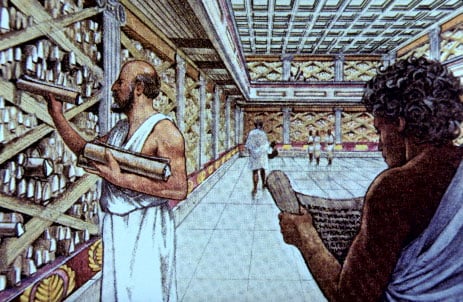Over the centuries, the Library of Alexandria was one of the largest and most significant libraries in the ancient world. The great thinkers of the age, scientists, mathematicians, poets from all civilizations came to study and exchange ideas. As many as 700,000 scrolls filled the shelves. However, in one of the greatest tragedies of the academic world, the Library became lost to history and scholars are still not able to agree on how it was destroyed.

An artist’s depiction of the Library of Alexandria. Image source.
Perhaps one of the most interesting accounts of its destruction comes from the accounts of the Roman writers. According to several authors, the Library of Alexandria was accidentally destroyed by Julius Caesar during the siege of Alexandria in 48 BC. Plutarch, for instance, provides this account:
when the enemy tried to cut off his (Julius Caesar’s) fleet, he was forced to repel the danger by using fire, and this spread from the dockyards and destroyed the great library.
(Plutarch, The Life of Julius Caesar, 49.6)
This account is dubious, however, as the Musaeum (or Mouseion) at Alexandria, which was right next to the library was unharmed, as it was mentioned by the geographer Strabo about 30 years after Caesar’s siege of Alexandria. Nevertheless, Strabo does not mention the Library of Alexandria itself, thereby supporting the claim that Caesar was responsible for burning it down. However, as the Library was attached to the Musaeum, and Strabo did mention the latter, it is possible that the library was still in existence during Strabo’s time. The omission of the library can perhaps be attributed either to the possibility that Strabo felt no need to mention the library, as he had already mentioned the Musaeum, or that the library was no longer the centre of scholarship that it once was (the idea of ‘budget cuts’ seems increasingly probable). In addition, it has been suggested that it was not the library, but the warehouses near the port, which stored manuscripts, that was destroyed by Caesar’s fire.
The second possible culprit would be the Christians of the 4th century AD. In 391 AD, the Emperor Theodosius issued a decree that officially outlawed pagan practices. Thus, the Serapeum or Temple of Serapis in Alexandria was destroyed. However, this was not the Library of Alexandria, or for that matter, a library of any sort. Furthermore, no ancient sources mention the destruction of any library at this time at all. Hence, there is no evidence that the Christians of the 4th century destroyed the Library of Alexandria.
The last possible perpetrator of this crime would be the Muslim Caliph, Omar. According to this story, a certain “John Grammaticus” (490–570) asks Amr, the victorious Muslim general, for the “books in the royal library." Amr writes to the Omar for instructions and Omar replies: "If those books are in agreement with the Quran, we have no need of them; and if these are opposed to the Quran, destroy them.” There are at least two problems with this story. Firstly, there is no mention of any library, only books. Secondly, this was written by a Syrian Christian writer, and may have been invented to tarnish the image of Omar.
No comments:
Post a Comment